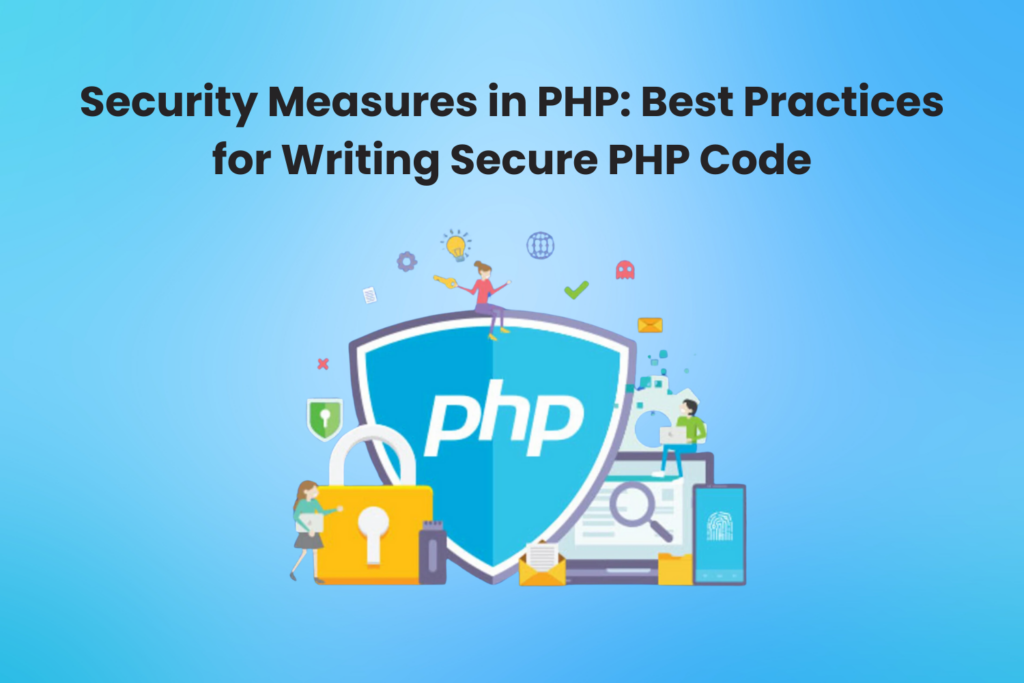The intricacies of safe coding techniques become crucial to understand while pursuing Programming Training, especially for web development. Understanding the fundamentals of protecting your code against possible attacks is critical in this digital age when the virtual world is full of potential weaknesses.

In this blog, we examine recommended practices that improve the security of your code while focusing on PHP, one of the mainstays of online development. However, before delving into the nuances of PHP security, let’s quickly answer the central query: What is PHP?
Table of Contents
• Unravelling the Essence of PHP
• Sanitizing User Input
• The Cryptic World of Password Hashing
• Escaping the Clutches of SQL Injection
• Embracing the HTTPS Shield
• Restricting Access with Effective File Permissions
• Vigilance in Session Management
• The Power of Regular Software Updates
• Navigating Cross-Site Scripting (XSS) Minefields
• Fortifying Against Cross-Site Request Forgery (CSRF) Attacks
• Wrapping Up
Unravelling the Essence of PHP
The server-side programming language PHP, or Hypertext Preprocessor, is often used in web development. PHP is well known for its adaptability and simplicity of HTML integration, which enable developers to create dynamic, interactive websites with smooth operation. After establishing the scene, let’s examine the maze-like security precautions for writing robust PHP code.
Sanitizing User Input
User input is an essential component of web applications and a potential weakness. One of the core security principles taught in PHP programming courses is to carefully check and clean user inputs before handling them. This guarantees that attempts at SQL injection or malicious scripts are stopped right at the entrance point. Using tools like “htmlspecialchars” and “mysqli_real_escape_string,” you can protect your application from malicious vulnerabilities and be strong gatekeepers.
The Cryptic World of Password Hashing
Since passwords are the digital keys to user accounts, further security is necessary. When saving passwords in PHP, hashing methods like bcrypt or Argon2 should be used. An additional layer of complexity called “salting” adds spice to the hashing process, making it more difficult for prospective hackers to break the algorithm. Adopting these procedures protects confidential user information and complies with industry requirements for solid password security.
Escaping the Clutches of SQL Injection
Because SQL injection is still a constant issue in the world of cybersecurity, PHP developers must protect their code against this sneaky vulnerability. The magic bullets that stop SQL injection attempts are prepared statements and parameterised queries, which separate user input from SQL instructions. This defence guarantees that malicious SQL code, even if inserted, is rendered inactive and unable to damage your database.
Embracing the HTTPS Shield
Data encryption is becoming a must as it travels across the vast networks of the internet. An extra degree of security is added when teaching a solid adherence to HTTPS inside the framework of PHP programming instruction. SSL/TLS certificates encrypt data while it is in transit to prevent eavesdroppers and improve the integrity of your online application.
Restricting Access with Effective File Permissions
PHP code is a component of a larger ecosystem of files and folders; it does not live in a vacuum. Enforcing strict file permissions is like securing the castle entrance. Restricting access to necessary files and folders prevents illegal modification or execution, preventing possible attackers from taking advantage of holes in your program.
Vigilance in Session Management
The transient connections known as sessions, which save the user state, must be handled carefully. Using “session_start()” in conjunction with secure session settings is a fundamental component of PHP security. A strong defence against session-based assaults includes regenerating session IDs after login, imposing session timeouts, and securely storing session data.
The Power of Regular Software Updates
The search for impermeable code in cybersecurity is a never-ending adventure. Regularly updating PHP and its related libraries is like defending your castle against new attacks. Keeping up with security patches and upgrades guarantees that your code will continue functioning well even when vulnerabilities change.
Navigating Cross-Site Scripting (XSS) Minefields
The threat of Cross-Site Scripting (XSS) is a significant concern in online security. PHP developers need to manoeuvre through this maze with skill. Using output encoding functions such as “htmlspecialchars” becomes essential for thwarting cross-site scripting attacks. Before displaying user-generated material in HTML, developers sanitise it to provide an impenetrable barrier against introducing harmful scripts.
Fortifying Against Cross-Site Request Forgery (CSRF) Attacks
PHP security goes beyond just preventing scripts from running. Cross-Site Request Forgery (CSRF) attacks are a covert danger that may be used to manipulate a user’s faith in a website. With thorough knowledge gained from training, developers can use anti-CSRF tokens. By serving as digital signatures, these tokens authenticate incoming requests. PHP programs defend against unwanted operations and possible data breaches by fortifying against CSRF.
Wrapping Up
The developers are responsible for writing secure PHP code for web development. Vulnerabilities in the digital shadows may be efficiently eliminated with careful programming instruction and adherence to best practices. Recall that strengthening your PHP code is a commitment to protecting the confidence and privacy of people who entrust their data to your online apps, not merely a technical need. Thus, let security be your constant companion as you begin your PHP coding journey to ensure a strong and durable future for your digital works.